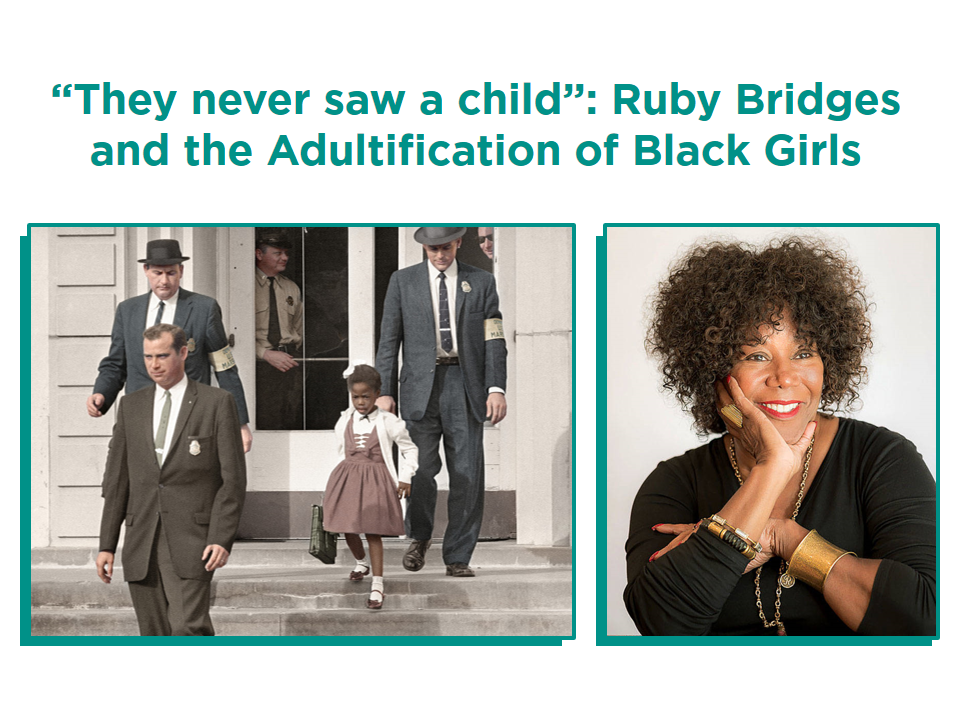
First Black students to integrate into all-White schools
It is a sunny day in New Orleans, and a young girl is on her ride to school. Along the way, she can see glimmers outside the window, light reflecting off of barricades on either side of the street. There are people standing behind them, tons of people. She thinks excitedly that today must be Mardi Gras. Why else would there be crowds in the streets?
But when the car stops, she hears the chanting. This crowd is not celebrating, nor throwing their hands up in jubilee – they are screaming angrily. “2, 4, 6, 8! We don’t want to INTEGRATE!”
Federal marshals surrounded her on the morning of November 14th, 1960, leading the small form of 6-year-old Ruby Bridges through a sea of furious White faces. Before she left home, Ruby was given her lunchbox and told that she would be going to a new school, William J. Frantz Elementary School, that day. And that was all. There was no sit-down discussion, no painful explanation about the drawn-out legal decision that meant she and three other girls would be the first black students to integrate into two all-White public schools in New Orleans. She had no idea the months of torment and threat that she would face; she was not scared. She did not leave that morning as a civil activist, with the weight of desegregation laid heavy on her shoulders.
She was just a six-year-old girl, sent off to a new school and told to behave.
From over 500 students to 1 student: Ruby Bridges
When she finally entered the school, rabid parents swarmed in behind her. The “Cheerleaders,” as the mob outside referred to themselves, clapped and hollered as White parents forcibly removed their kids from the building. Over 500 children were pulled from the school that day rather than having to attend with just one black child. Across the city, Leona Tate, Gail Etienne, and Tessie Prevost were met with similar ire at McDonough No. 19 Elementary School. Angry White parents boycotted the schools and admonished other parents into pulling their children out as well. Beyond their words, they destroyed property and harassed and threatened families sympathetic to school integration. Encouraged by the school board’s pro-segregation stance, the New Orleans School Crisis persisted until the federal government threatened the use of force to uphold desegregation in the coming school year.
From January to May of 1961, as parents boycotted the integration, Ruby Bridges was the only student, Black or White, in attendance at William J. Frantz Elementary School. She suffered threats to her life through these months. At one point, Ruby stopped eating the lunches her mother sent with her to school, facing threats by protesters that her food would be poisoned. Her perseverance and continued walk to school through the crowd was immortalized in art, publicized across the country, and received national response.
Adultification of Black girls: their stolen childhood
Over 60 years have passed since her first day. Just over half a century, then, since a little girl had to be escorted to and from school for months at a time, through a gauntlet of adults who spent months making her fear for her life. Why? Because, as Ruby claims in a PBS interview as an adult, “they never saw a child. They saw change, and what they thought was being taken from them.”
The adultification of young Black girls remains a deeply rooted social problem with damaging ramifications. Much like theories for segregation, this concept dates back to African enslavement when children as young as 2 or 3 were put to work as adults and punished for exhibiting age-appropriate behaviors. Historically, treating Black children as adults gave license for their punishments to be more severe, and therefore excused racist abuses.
The tradition of stealing childhoods from Black children, specifically girls, continues into trends that can be seen in recent years. When asking over 300 parents in 2017, the Georgetown Law Center on Poverty and Inequality found that adults on average viewed Black girls as more “adult” than White girls of the same age – this difference was most noticeable in middle childhood, from ages 5-9 and 10-14. Starting as young as five years old, Black girls were viewed as knowing more about adult topics such as sex, and more able to take on adult roles and responsibilities. As a result, children are not afforded the same opportunities as other children to learn, grow, and make the mistakes that are common in children their age.
Young Black girls unfairly punished in school
This effect is not only perception, however – the same study asserts that adultification of young Black girls could contribute to disproportionate school discipline. In the 2013-2014 school year, Black girls were twice as likely to be disciplined for minor rule violations, and three times as likely to be cited for disruptive behavior, bullying, or fighting compared to White girls. In this school year, while Black girls in grades K-12 represented only 8% (that’s 8 out of every 100 children) of the total students enrolled, they accounted for 13% of the total suspensions. And, if these disruptions to education and social connections don’t fully explain the damage this mindset can cause, it leads to further irreparable consequences. Black girls are 2.7 times more likely than their White peers to be referred to juvenile justice, where they consistently receive harsher sentences than White girls when controlled for offense, prior legal record, and age. It makes sense, of course, that if Black girls are more likely to be seen as adults when misbehaving, they are also more likely to be seen as culpable for their actions and receive harsher punishment.
Adultification is a form of dehumanization, robbing black children of the very essence of what makes childhood distinct from all other developmental periods: innocence. Adultification contributes to a false narrative that black youths’ transgressions are intentional and malicious, instead of the result of immature decision-making — a key characteristic of childhood. -Girlhood Interrupted: Erasure of Black Girls’ Childhood
Ruby Bridges today: civil rights activist
Many things have yet to change since Ruby Bridges’s first day. Just over half a century ago, this little girl became the face of a legal movement to end segregation in schools in Louisiana. To this day, young Black girls are perceived to be less needing of love, less deserving of leniency, and less innocent than their peers. They are pushed toward adulthood long before their childhood years have begun to end.
Following her part in the monumental move toward integration in the state of Louisiana, Ruby Bridges has become an advocate for civil rights and represents a hallmark of bravery. She is the founder of The Ruby Bridges Foundation, which works to advocate for diversity education and conflict management. She travels the world as a speaker, and even has her own podcast. As of this post, Ruby Bridges is living in New Orleans. She is 69 years old.
As a child, she was thrust into activism in the way of falling into deep water, immediately and irrevocably. Through torment, she held her head high and took on the terrible world without turning back. Now, she fights for diversity and the inclusion of other young black children – she speaks around the world, inspiring people from classrooms full of smiling faces to the 44th President of the United States.
Breaking down racial stereotypes with the HOPE framework
As we work toward integrating the HOPE framework and the Four Building Blocks of HOPE into practice and policy across the nation, stereotypes such as adultification and their effect on equitable environments must be at the forefront of our awareness. To provide access to safe and equitable environments to learn and play, we must take a hard look at the unrealistic and unjust expectations we have for Black girls. Systemic problems arise from widespread biases that lead to disparities in treatment. To build a future for all children requires allowing them the full scope of their childhood, in an environment where they feel free to explore and make mistakes.
Despite the incredible challenges Ruby Bridges faced, she shows us the resilience and strength that young Black girls display every day in America. Imagine if we, as a society, allowed young girls of color to just be children and develop at their own pace without the pressure of the world on their shoulders. Young Black girls have the power to change the world in amazing and inconceivable ways, and if we work to end the problem of adultification this power and potential can be fully realized.
Honoring Rudy Bridge’s legacy
For parents, talk to your children—or other parents in your community—about Ruby Bridges’s experience, and your own stories. Ruby’s story can prompt great conversations. Consider reading Ruby Bridges Goes To School: My True Story with your child. Engage in thoughtful discussion questions such as:
- Is their school integrated?
- What do they think adults think about diversity in the schools?
- What have you learned about children who don’t look like you? Did it surprise you?
- Have you ever been treated, or seen another child treated unfairly because of their race or skin color?
- Even though Ruby made school integration possible, what still needs to be done today?
On a political level, there is much that needs to be done to honor Ruby’s legacy – and to make sure that every child has a safe and equitable environment in which to live, learn, and play. Check out these links for more ideas:
- NAACP Legal Defense Fund: Statement on New Research Showing an Increase in School Segregation in the South
- “What Racism in Schools Looks Like” by George Farmer
HOPE Resources on Anti-racism
- HOPE and Anti-racism Approaches (free online course)
- HOPE as an Anti-Racism Framework in Action (fact sheet)
- HOPE Anti-racism Statement


